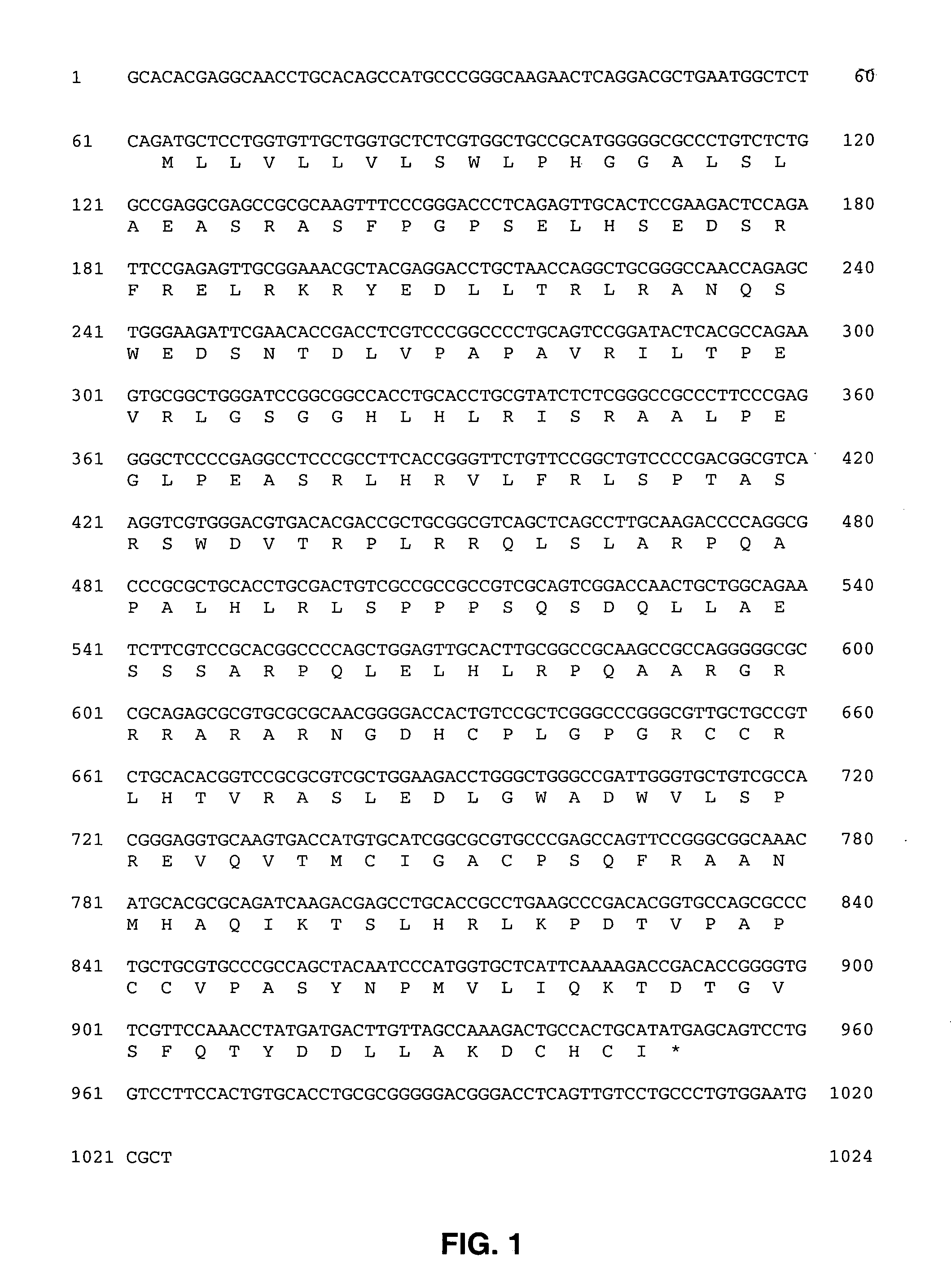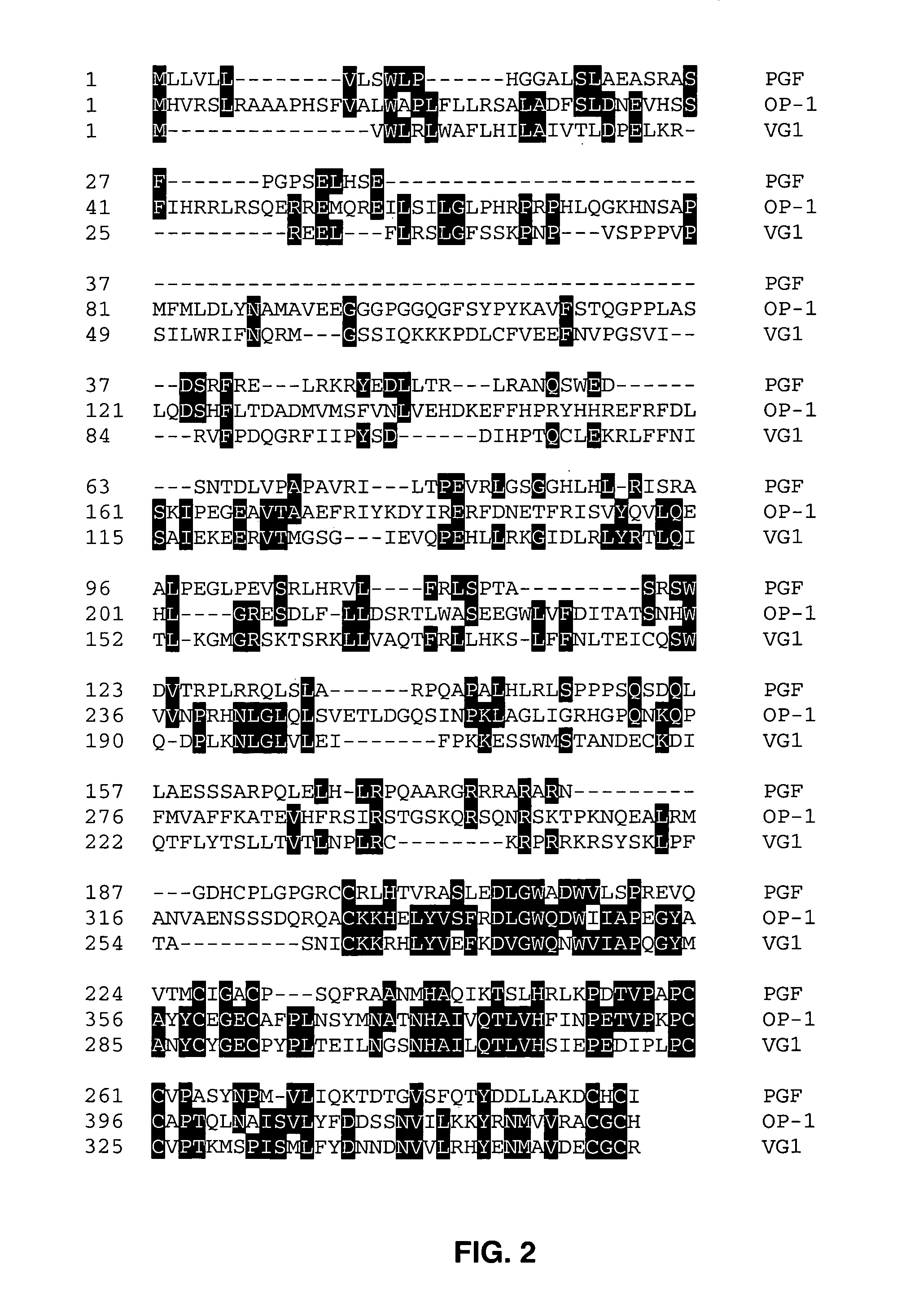Prostatic growth factor
a growth factor and prostatic technology, applied in the field of prostatic growth factor, can solve the problems of cancer, uncontrollable growth of cells that lose the ability to respond to tgf-, and fiber formation in the extracellular matrix of liver and lung, and can be fatal
- Summary
- Abstract
- Description
- Claims
- Application Information
AI Technical Summary
Benefits of technology
Problems solved by technology
Method used
Image
Examples
example 1
Bacterial Expression And Purification of PGF
[0108]The DNA sequence encoding PGF, ATCC #75902, is initially amplified using PCR oligonucleotide primers corresponding to the 5′ and 3′ termini. Additional nucleotides corresponding to PGF are added to the 5′ and 3′ sequences, respectively. The 5′ oligonucleotide primer, which contains a HindIII restriction enzyme site followed by 21 nucleotides of PGF coding sequence starting from the first amino acid, has the sequence:[0109]5′ CGCGCGAAGCTTATGCTCCTGGTGTTGCTGGTG 3′ (SEQ ID NO:5).
The 3′ oligonucleotide primer, which contains complementary sequences to an XbaI site and is followed by 21 nucleotides of PGF, has the sequence:[0110]5′ GCGCGCTCTAGATCATATGCAGTGGCAGTCTTT 3′ (SEQ ID NO:6).
[0111]The restriction enzyme sites correspond to the restriction enzyme sites on the bacterial expression vector pQE-9 (Qiagen, Inc. 9259 Eton Avenue, Chatsworth, Calif., 91311). pQE-9 encodes antibiotic resistance (Ampr), a bacterial origin of replication (ori)...
example 2
Expression of Recombinant PGF in COS Cells
[0113]The expression of plasmid, PGF HA is derived from a vector N11 containing: 1) SV40 origin of replication, 2) ampicillin resistance gene, 3) E. coli replication origin, 4) CMV promoter followed by a polylinker region, a rat preproinsulin 3′ intron and polyadenylation site. A DNA fragment encoding the entire PGF precursor and a HA tag fused in frame to its 3′ end was cloned into the polylinker region of the vector, therefore, the recombinant protein expression is directed under the CMV promoter. The HA tag correspond to an epitope derived from the influenza hemagglutinin protein as previously described (I. Wilson, H. Niman, R. Heighten, A Cherenson, M. Connolly, and R. Lerner, 1984, Cell 37, 767). The infusion of HA tag to our target protein allows easy detection of the recombinant protein with an antibody that recognizes the HA epitope.
[0114]The plasmid construction strategy is described as follows. The DNA sequence encoding PGF, ATCC #...
example 3
Expression Pattern of PGF in Human Tissue
[0120]Northern blot analysis was carried out to examine the levels of expression of PGF in human tissues. Total cellular RNA samples were isolated with RNAzol™ B system (Biotecx Laboratories, Inc. 6023 South Loop East, Houston, Tex. 77033). About 10 ug of total RNA isolated from each human tissue specified was separated on 1% agarose gel and blotted onto a nylon filter (Sambrook, Fritsch, and Maniatis, Molecular Cloning, Cold Spring Harbor Press, (1989)). The labeling reaction was done according to the Stratagene Prime-It kit with 50 ng DNA fragment. The labeled DNA was purified with a Select-G-50 column (5 Prime-3 Prime, Inc. Boulder, Colo. 80303). The filter was then hybridized with radioactive labeled full length PGF gene at 1,000,000 cpm / ml in 0.5 M NaPO4, pH 7.4 and 7% SDS overnight at 65 degrees C. After wash twice at room temperature and twice at 60 degrees C. with 0.5×SSC, 0.1% SDS, the filter was then exposed at −70 degrees C. overni...
PUM
| Property | Measurement | Unit |
|---|---|---|
| volume | aaaaa | aaaaa |
| body weight | aaaaa | aaaaa |
| pH | aaaaa | aaaaa |
Abstract
Description
Claims
Application Information
 Login to View More
Login to View More - R&D
- Intellectual Property
- Life Sciences
- Materials
- Tech Scout
- Unparalleled Data Quality
- Higher Quality Content
- 60% Fewer Hallucinations
Browse by: Latest US Patents, China's latest patents, Technical Efficacy Thesaurus, Application Domain, Technology Topic, Popular Technical Reports.
© 2025 PatSnap. All rights reserved.Legal|Privacy policy|Modern Slavery Act Transparency Statement|Sitemap|About US| Contact US: help@patsnap.com


